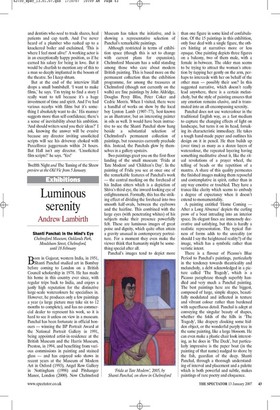Luminous serenity
Andrew Lambirth Shanti Panchal: In the Mind's Eye Chelmsford Museum, Oaklands Park Moulsham Street, Chelmsford, until 18 Feb/vary Born in Gujarat, western India, in 1951, Shanti Panchal studied art in Bombay before coming to London on a British Council scholarship in 1978. He has made his home in this country ever since, with regular trips back to India, and enjoys a justly high reputation for the distinctive large-scale watercolours he specialises in. However, he produces only a few paintings a year (a large picture may take six to 12 months to complete), and has no commercial dealer to represent his work, so it is hard to see it unless on view in a museum. Panchal has been fortunate in official honours — winning the BP Portrait Award at the National Portrait Gallery in 1991, being appointed artist-in-residence at the British Museum and the Harris Museum, Preston, in 1994, and benefiting from various commissions in painting and stained glass — and has enjoyed solo shows in recent years at the Museum of Modern Art in Oxford (1993), Angel Row Gallery in Nottingham (1998) and Pitshanger Manor, London (2000). Now Chelmsford www.spectator.co.uk Museum has taken the initiative, and is showing a representative selection of Panchal's remarkable paintings.
Although restricted in terms of exhibition space (though this is set to change with current plans for expansion), Chelmsford Museum has a solid standing among those who care about modern British painting. This is based more on the permanent collection than the exhibition programme, for among the treasures at Chelmsford (though not currently on the walls) are fine paintings by John Aldridge, Douglas Percy Bliss, Peter Coker and Cedric Morris. When I visited, there were a handful of works on show by the local boy Lynton Lamb (1907-77), best-known as an illustrator, but an interesting painter in oils as well. It would have been instructive to see the Shanti Panchal show hung beside a substantial selection of Chelmsford's permanent collection of paintings, but resources currently preclude this. Instead, the Panchals glow by themselves in a gallery upstairs.
Two paintings greet you on the first-floor landing of the small museum: Trida at Tate Modern' and 'Children's Day'. In the painting of Frida you see at once one of the remarkable features of Panchal's work — the central marking on the forehead of his Indian sitters which is a depiction of Shiva's third eye, the inward-looking eye of enlightenment. Formally, this has the striking effect of dividing the forehead into two smooth half-ovals, between the eyebrows and the hairline. This combined with the large eyes (with penetrating whites) of his subjects make their presence powerfully felt. These are luminous images of great poise and dignity, which quite often attain a gravity unusual in contemporary portraiture. For a moment they even make the viewer think that humanity might be something special after all.
Panchal's images tend to depict more than one figure in some kind of confabulation. Of the 15 paintings in this exhibition, only four deal with a single figure, the others hinting at narratives more or less opaque. One painting depicts three figures on a balcony, two of them male, with a female in-between. The older man seems to be trying to attract the woman's attention by tapping her gently on the arm, perhaps to intercede with her on behalf of the other man — possibly their son? In this suggested narrative, which doesn't really lead anywhere, there is a certain melancholy, but the style of painting ensures that any emotion remains elusive, and is transmuted into an all-encompassing serenity.
Panchal does not use watercolour in the traditional English way, as a fast medium to capture the changing effects of light on landscape, but turns it on its head, forsaking its characteristic immediacy. He takes a tough hand-made paper and outlines his design on it in pencil. He then builds up (over time) as many as a dozen layers of watercolour, the repeated layering having something meditative about it, like the ritual revolutions of a prayer wheel, the telling of beads or the repetition of a mantra. A share of this quality permeates the finished images making them reposeful and contemplative in spirit, rather than in any way emotive or troubled. They have a trance-like clarity which seems to embody a degree of expectancy when it doesn't extend to monumentality.
A painting entitled 'Home Coming — After a Long Absence' depicts the curling prow of a boat intruding into an interior space. Its elegant lines are immensely decorative and satisfying, but this is hardly a realistic representation. The typical flatness of forms adds to the unreality (or should I say the heightened reality?) of the image, which has a symbolic rather than veristic intent.
There is a flavour of Picasso's Blue Period to Panchal's paintings, particularly in the tendency towards theatricality and melancholy, a debt acknowledged in a picture called 'The Tragedy', which is a Picasso paraphrase though superbly handled and very much a Panchal painting. The best paintings here are the biggest, composed of large, simple shapes, beautifully modulated and inflected in texture and vibrant colour rather than burdened with superfluous detail. Panchal is adept at conveying the singular beauty of shapes, whether the folds of the hills in 'The Tragedy', like drapery cloaking some hidden object, or the wonderful purply tree in the same painting, like a large blossom. He can even make a plastic chair look interesting, as he does in 'The Deck', but particularly impressive is the paper boat (in the painting of that name) nudged to shore by the fish, guardian of the deep. Shanti Panchal, through a thorough understanding of interval and placement and a palette which is both powerful and subtle, makes paintings of rare poetry and eloquence.






















































 Previous page
Previous page